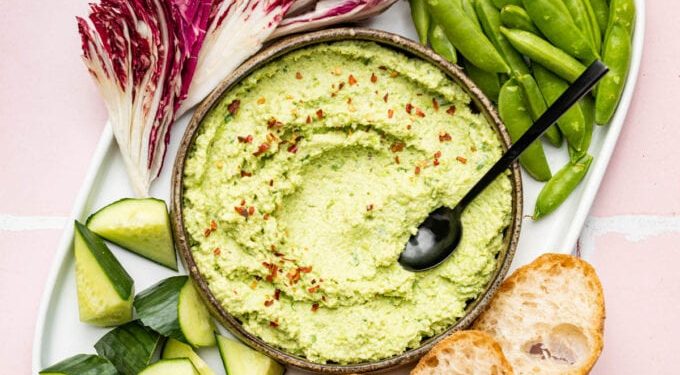Even on a low FODMAP diet for IBS, getting enough fiber is important! Learn why, along with how to increase fiber intake safely, a list of low FODMAP high fiber foods and more, from a gut health registered dietitian with 15 years of experience (and author of Good For Your Gut!)

Are you on a low FODMAP diet for IBS right now? Chances are, you aren’t eating enough fibre. Which isn’t ideal, because fibre is SO important for helping to regulate digestion, avoid constipation and create a healthy gut microbiome.
As a gut health dietitian and member of the irritable bowel syndrome club, you could say that I am a founding member of the fibre fan club (ha, can you imagine the nerdy t-shirts?). A dietitian in love with fibre isn’t news…but clearly, we’re not getting the memo: the vast majority of us just don’t eat enough.
So I’ll give it to you straight: our collective gut health is off the rails right now. Many of us are either constipated, suffering from chronic reflux, or have irritable bowel syndrome. Rates of the inflammatory bowel diseases Crohn’s disease and ulcerative colitis are on the rise.
And one of the simplest – and most profound – steps we can take to improve gut health is to eat more high fibre foods. But what if you’re low FODMAP? Or eating high fibre foods causes symptoms?
I’ve got over a decade of experience in complex gut health nutrition, so let me show you the way…this post will get you started but if you need more, consider picking up a copy of my book Good For Your Gut, which includes over 90 recipes (about ⅓ of them are low FODMAP recipes!)
Ready? Let’s do this!
- Why is fiber important on a low FODMAP diet?
- How much fiber do you need?
- How to increase fiber intake safely
- FODMAPs vs fiber
- 22+ Low FODMAP high fiber foods for IBS
- Low FODMAP fiber supplements
Why is fiber important on a low FODMAP diet?
When you’ve got irritable bowel syndrome, you’ve probably had the experience of high fiber foods like a bean-filled chili or a fruit salad making you feel much worse…so I understand that you might be a bit skeptical about the benefits of fiber for IBS.
And it’s true: when things are off the rails, insoluble fibres like cereal or vegetable fibres might make you feel worse in the moment. Soluble fibers like those in oranges and oats tend to be far gentler and they are usually the first place we start for those with the most irritated guts.
But ALL fibres have their place in an IBS-friendly eating plan, particularly when you are already managing symptoms with a low FODMAP diet. Here’s why fibre is so good for you.
- Keeping the digestive tract healthy: soluble fibres form a gel that can bind unwanted substances in the gut and carry them out of the body. Insoluble fibres help to sweep the gut lining, encouraging proper turnover of the gut cells.
- Regulating bowel movements: the gel-like nature of soluble fibre hydrates stools, making them easier to pass. Insoluble fibre helps keep things moving in a timely fashion.
- Feeding the gut microbiome: fermentable fibres – which admittedly are greatly reduced when low FODMAP – help feed the gut microbiome to keep it strong.
- Decreasing risk of chronic disease: soluble beta-glucan fibre in oats can help lower cholesterol; high fibre intake is also associated with lower risk of high blood pressure, may help to keep blood sugars balanced and may contribute to lower risk of colorectal cancer.
How much fiber do you need?
How much fibre we need to eat is tied to how much we eat: clinically, we say we need 14g of fiber per 1000 calories consumed but as I am staunchly against calorie counting in real life, it’s not very helpful.
My advice? People with smaller, less active bodies (and smaller appetites) should aim for 25 grams of fibre daily while those with larger, more active bodies (and larger appetites) should aim for as much as 38 grams of fibre daily.
If your fiber intake is somewhere along that range, you’re doing great! On a low FODMAP diet, the higher side of that spectrum is a bit harder to reach – and it’s okay if you don’t always get there – but maintaining a focus on eating more high fibre foods will help ensure you get a decent amount.
How to increase fiber intake safely
For the love of all things fiber, it’s critical that you do NOT attempt to go from a low fiber to a high fibre diet overnight. Even for someone without any gut condition, doing so can make you bloated, gassy and even constipated (and miserable!).
Think of it this way: you need to train your gut for fiber tolerance the same way you train at the gym. You wouldn’t attempt to lift 50 pound dumbbells on day one. So don’t think you can crush 50 grams of fiber immediately either.
If you have IBS, the same is doubly true, even with low FODMAP high fiber foods. Increasing your fibre intake is ALWAYS better one-on-one with a dietitian, but if that’s not available to you, here is what you need to know:
- It is NORMAL to have mild increased symptoms when you increase fibre. I’m talking gas, bloating, a little extra urgency. If symptoms are sharp, painful, or alarming, immediately talk to your doctor.
- The most irritated guts should start with soluble fibre only. Gel-forming soluble fibre is less irritating than soluble fibre. I have noted soluble fibre predominant foods in the list below for ease.
- Start by introducing only one high fibre food a day. Add another high fibre serving to your day ONLY when you no longer notice symptoms. For some, that might be day 2….others might need a few weeks to adjust to a single high fibre food. Listen to your body.
- You MUST drink more water when you add fibre. A good rule of thumb? Drink one more glass of water for each high fibre serving you add.
- Consistency is key: your gut thrives on routine. It is far better to eat just one high fibre food every single day than to eat 4 high fibre foods one day and zero the next.
Wait, aren’t FODMAPs like fructans actually fiber?
If you’re deep into gut geekery, you might be wondering what the heck FODMAPs are if they aren’t fibre. Especially since we call inulin, the FODMAP in wheat, a functional fibre.
But not all FODMAPs are the same thing; it is most accurate to call FODMAPs fermentable carbohydrates. Because some, like fructose and lactose, are actually sugars…just ones that we don’t all digest that well. Fructans and GOS, however, are considered dietary fibres as they are long chains of carbohydrates that we don’t digest at all.
But there are SO many different types of dietary fibre…more than the FODMAP ones…so yes, there are dietary fibres that are not FODMAPs.
22+ Low FODMAP high fiber foods for IBS
This is where you get your fibre on a low FODMAP diet! I have given you the exact low FODMAP serving sizes and amount of fibre in each serving, including foods with 2 grams of fibre or more per serving. I have also added * to the foods that are predominantly soluble fibre that will be less irritating to more sensitive guts. Cooking vegetables will make them easier on the gut too.
Fruits + Vegetables
- Blueberries* 1 cup blueberries contains 4 grams of fiber
- Carrots 1 cup sliced raw carrot contains 3 grams of fiber
- Chard ½ cup cooked chard contains 2 grams of fiber
- Collards ½ cup cooked collards contain 4 grams of fiber (collards contain osmotic sugars that might loosen BMs)
- Eggplant* 1 cup cubed raw eggplant contains 2.5 grams of fiber
- Kale 2 cups raw kale contains 3.5 grams of fiber
- Kiwi* 2 small kiwis contain 4 grams of fiber
- Oranges* 1 medium orange contains 3 grams of fiber
- Parsnip 1 medium parsnip contains 3 grams of fiber
- Potato with Skin 1 medium potato with skin contains 4 grams of fiber
- Raspberry* ⅓ cup (58g) raspberries contains 3 grams of fiber
Low FODMAP Whole Grains
- Brown Rice 1 cup cooked brown rice contains 3 grams of fiber
- Oats* ½ cup dry rolled oats contains 5.5 grams of fiber
- Popcorn 4 cups air-popped popcorn contains 5 grams of fiber
- Quinoa 1 cup cooked quinoa contains 5.5 grams of fiber
Nuts + Seeds
- Chia seeds* 2 tablespoons whole chia seeds contain 7 grams of fiber
- Flax* 1 tablespoon ground flax contains 2 grams of fiber
- Peanuts 32 peanuts (1 ounce) contains 2.5 grams of fiber
- Walnuts 10 walnut halves contains 2 grams of fiber
Legumes
- Chickpeas ¼ cup canned, rinsed chickpeas contains 2 grams of fiber
- Edamame ½ cup cooked shelled edamame contains 4 grams of fiber
- Lentils ¼ cup canned, rinsed lentils contains 2 grams of fiber
- Tofu 1 cup tofu contains 2.5 grams of fiber
- Tempeh ½ cup of tempeh contains 6 grams of fiber
All low FODMAP servings were verified on the MONASH app March 2023. Fiber totals from Canadian Nutrient File.
Is there a low FODMAP fiber supplement?
If you are looking for a low FODMAP fibre supplement, there are two good soluble fibre options to choose from: psyllium and Partially Hydrolyzed Guar Gum (PHGG). For those with the most irritated guts, this is one time where a supplement might be the gentlest option at first.
Psyllium fibre comes from the plantago ovata plant. It is the fibre supplement I recommend most often as it has the most research for its use in irritable bowel syndrome. Psyllium is low fermentation, so less likely to cause gas and bloating. Learn more about psyllium and how to use it. Metamucil is psyllium fiber, and you can get raw psyllium husks too.
Partially hydrolyzed guar gum (PHGG) is another good option. PHGG also comes from a seed, of the guar plant (Cyamopsis tetragonoloba). You find PHGG under the brand name Sunfiber. PHGG is a low FODMAP prebiotic fiber that may be of use in both constipation and diarrhea-predominant IBS.
Both of these are bulk-forming fibres that are used as laxatives…but they are not habit forming the way osmotic or stimulant laxatives are. Always talk to your doctor or pharmacist if you’re on medications, as fibre supplement can interfere with medications (definitely separate the two!!).
I hope this was helpful! Have questions? Share them in the comments below…
The post Fiber and IBS: A list of 22+ low FODMAP high fiber foods appeared first on Desiree Nielsen.












